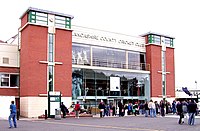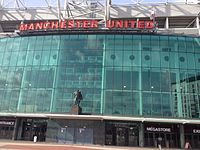Old Trafford
| Old Trafford | |
| Lancashire | |
|---|---|
| Location | |
| Grid reference: | SJ825955 |
| Location: | 53°27’37"N, 2°17’13"W |
| Data | |
| Population: | 13,000 (approx.) |
| Post town: | Manchester |
| Postcode: | M16 |
| Dialling code: | 0161 |
| Local Government | |
| Council: | Trafford |
| Parliamentary constituency: |
Stretford and Urmston |
Old Trafford is a town in southern Lancashire which has become swallowed in the conurbations in the south of that county, two miles southwest of Manchester city centre. Amongst he contiguous townscape, the crossroads sites of two old toll gates roughly delineate the borders of the area: Brooks's Bar to the east and Trafford Bar to the west.
Old Trafford is the site of two major sporting venues: Old Trafford football stadium, home of Manchester United F.C., and Old Trafford Cricket Ground, home of Lancashire County Cricket Club. These are at either end of Warwick Road, two parts of which have been renamed Brian Statham Way (formerly Warwick Road) and Sir Matt Busby Way (formerly Warwick Road North). The interconnecting strip of road between retains the name Warwick Road, and the southern section on the other side of the Metrolink line is called Warwick Road South.
Clare Hartwell in her book Buildings of Manchester & South East Lancashire suggests Old Trafford is "part of Manchester functionally and visually and the boundary, south west of the Manchester centre, is nowhere noticeable".
History
Old Trafford was a crossing point over the River Irwell in ancient times. The name 'Old Trafford' possibly derives from the time when there were two Trafford Halls, Old Trafford Hall and New Trafford Hall. The old hall was close to what is now the White City Retail Park, and was said to have been the home of the de Trafford family since 1017, until the family moved to the new hall in what is now Trafford Park, some time between 1672 and 1720.[1] The name of the area around Old Trafford Hall may subsequently have become shortened to Old Trafford.[2] The old hall was demolished in 1939.[3]
In the 1820s, Manchester scientist John Dalton chose Old Trafford as the site for a Royal Horticultural and Botanical Gardens because of its clean, unpolluted air, and so began the area's association with sports and recreation. The popularity of the botanical gardens – which was a kind of northern Crystal Palace – led wealthy people to build large houses in the area. In 1857, and again in 1887, the gardens staged exhibitions of art treasures, the former as part of the Art Treasures Exhibition and the latter in celebration of Queen Victoria's silver jubilee. The Hallé Orchestra was formed to participate in the first of these exhibitions. The site of the botanical gardens was purchased by White City Limited in 1907, and it subsequently became an amusement park, although the name lives on in the street called Botanical Gardens. From the 1950s to the 1970s, White City Stadium was used as a greyhound racing track and for stock car racing. This site is now White City Retail Park. The front entrance is all that has been preserved of the old botanical gardens. Nearby, on the site of what is now the Police Headquarters, was Henshaw's Institute for the Blind, which originally opened as Henshaw's Blind Asylum in 1837. Next door on the same site was the Royal Institute for the Deaf, where the film Mandy was made.
Old Trafford expanded and became an urban area after the building of the Manchester Ship Canal in the 1890s, and the subsequent development of nearby Trafford Park Industrial Estate, in the early 20th century. Trafford Park provided employment for thousands of local residents. Employment was also provided on a smaller scale, notably by the railways (Trafford Park shed alone had over 300 staff), Duerr's Jams, Vimto, Arkady Soya Mill[4] and Ludwig Oppenheimer Mosaics. The Royal Army Medical Corps and the Territorial Army have well-established bases in the area.
Slum clearances during the 1960s and early 1970s saw some of the old Victorian housing stock demolished. However, after the perceived failure of the deck-access concrete crescents of Hulme, Old Trafford's residents preferred renovation to demolition. As a result, there are still many Victorian terraced streets in the area.
By 1985, employment at Trafford Park had fallen to 24,500, as unemployment in the northwest soared above 30 per cent in some inner-city areas. Nearby Manchester Docks, which had also been a major source of local employment, closed in 1982. As the revitalised Salford Quays it has become an emblematic part of the regeneration of Manchester in general.
Geography
The area is unusual in effectively being a peninsula. Its northern boundary was the River Irwell, now canalised into the Manchester Ship Canal. To the east was a tributary of the Irwell, the Cornbrook. This was culverted as the area grew in the 19th century. In fact, Victorian Hulme and Old Trafford seemed indistinguishable, as the hidden river made its way out of sight.
Similarly, the southern boundary was the Black Brook, which was culverted at about the same time as the Cornbrook. Thus Upper Chorlton Road, under which it flows, does not seem to be a natural boundary. Both sides of the road look similar, and Darley Park, on the Trafford side, could easily fit into Whalley Range. Some small anomalies due to the brook's underground route were not amended until the late 1980s.
The inter-war development of Firswood is almost indistinguishable from its Chorlton-cum-Hardy neighbours.
On the western side of the area, the road named Seymour Grove has an interesting origin. In the 19th century, the people of Chorlton called it Trafford Road, and the people of Old Trafford called it Chorlton Road. Neither name was appropriate, as nearby roads already had those names. So the area's richest inhabitant, a millionaire grocer called Sir Thomas Seymour Mead, decided the road should be named after him.
Old Trafford today
Today, Old Trafford has approximately 13,000 residents. Cultural diversity has been a feature of the area for over a century. Irish immigrants settled in the locality from the 1880s, coming to Manchester to work on the ship canal. Polish and east European migrants arrived during and after the Second World War. The West Indian community arrived and settled in the 1950s and 1960s. People from the Indian sub-continent started to arrive during the 1960s but settled in more significant numbers from the 1980s onwards.
Old Trafford is among the 10% most deprived areas in Britain, suffering problems of unemployment, poor housing and low educational achievement. It also has levels of youth crime well above the national average.
Ayres Road and its environs are the heart of modern-day Old Trafford and a walk down this road gives a real flavour of the multi-cultural nature of the neighbourhood, with its variety of grocers' shops selling food stuffs from Europe, the Caribbean and South-East Asia; its Roman Catholic church, St. Alphonsus, frequented by a predominantly Irish congregation, and Shizhan House, the Chinese Medicine Centre, on the site of the old Vimto offices. Something of this atmosphere is evoked by Manchester poet Lemn Sissay in his poem Ayres Road.
Sports
Old Trafford has been the site of Manchester United Football Club's Old Trafford stadium since 1910.
Lancashire County Cricket Club's ground, which is also known as Old Trafford, is close by. Before the club's formation, in 1864, it had been the home of Manchester Cricket Club, who had moved here in 1856.
The ground of the Northern Lawn Tennis Club was in Old Trafford from 1882 to 1909 (near the cricket ground): this is commemorated in the name of Tennis Street. The move to West Didsbury in 1909 was prompted by the industrialisation of Trafford Park and consequent air pollution. The half-timbered pavilion was dismantled and re-erected at the new ground.[5]
Outside links
- "Old Trafford News". http://www.otnews.co.uk/.
- "Friends of Old Trafford". http://www.foot.org.uk.
- "Guided Walk round Trafford". http://www.industrialpowerhouse.co.uk/audiotrafford.asp.
- "Art Treasures Exhibition 1857". Manchester City Art Gallery. http://www.manchestergalleries.org/whats-on/exhibitions/index.php?itemID=25.
References
- ↑ Nicholls 1996, p. 9.
- ↑ Masterson & Cliff 2002, pp. 12–13.
- ↑ Masterson & Cliff 2002, p. 69.
- ↑ http://www.trafford.gov.uk/forum/showthread.php?t=1158
- ↑ Phythian, Graham (2010) "Looking Back", in: South Manchester Reporter; 13 May 2010, p. 22
- Massey, Samuel (1976). A History of Stretford. John Sherratt and Son. ISBN 0-85427-046-9.
- Masterson, Vicki; Cliff, Karen (2002). Stretford An Illustrated History. The Breedon Books Publishing Company. ISBN 1-85983-321-7.
- Nicholls, Robert (1996). Trafford Park: The First Hundred Years. Phillimore & Co. ISBN 1-86077-013-4.
- Rendell, Douglas (1998). Cinemas of Trafford. Jarvis Print Group. ISBN 0-9512560-1-7.
- Spencer, Reuben (1897). A Survey of the History, Commerce and Manufactures of Lancashire; ... together with a biographical sketch of Reuben Spencer .... Biographical Publishing Co.. ISBN 0-9512560-1-7.
- Trafford Council (June 1994). Trafford, Greater Manchester. The British Publishing Company. Trafford1994.

